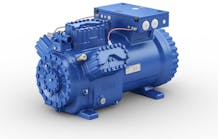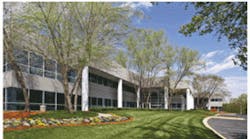To David Bowles, owner of Environmental Services of Charlotte Inc., a full-service HVAC company based in Charlotte, N.C., a nearby former corporate facility was more than an abandoned eyesore; it was an opportunity.
Bowles purchased the 70,000-sq-ft building in 2009, seeing it as the perfect place to carry out his vision for a multifaceted showcase of green-building capabilities.
"The building had 'good bones,'" Bowles said. "I saw a structure that could become one of the most energy-efficient in the region without necessarily breaking the bank."
Renamed Environmental Way, the facility was fully rehabilitated in 2009 and 2010 and now serves as a model of cutting-edge solutions—particularly in the realm of hydronic heating.
The Solution
Unoccupied for a decade, the building had a system consisting of inefficient cast-iron sectional boilers. The system drew 9 amps per boiler for the power burner motors.
"Our focus from the beginning was to utilize as many of the existing building features as possible," Bowles said. "HVAC and electrical often are two of the most costly components of a retrofit project, especially one that wants to 'go green.'"
Bowles contacted Eric Hobbs, vice president of Weeks-Williams-Devore Inc., a Matthews, N.C.-based manufacturer’s representative. Bowles shared the Environmental Way concept with Hobbs, indicating that once the retrofit project was completed, he intended to seek the highest level of certification under the U.S. Green Building Council's Leadership in Energy and Environmental Design (LEED) green-building rating system: Platinum.
Hobbs suggested the installation of two Pulse condensing hydronic boilers from Fulton to replace the aging system. With its ultrahigh efficiencies (up to 99 percent), low electrical consumption (less than 1 amp), low maintenance cost, and simple design, Pulse was the optimal solution for the project, Hobbs said.
Hobbs also recommended the installation of a ModSync boiler sequencing system with color touchscreen from Synex Controls. The system was custom-configured to operate the boilers at optimum efficiency.
One year later, natural-gas and electricity costs had been reduced, despite a significant increase in facility temperature, from the unoccupied temperature of 50°F to the occupied temperature of 72°F. The Pulse boilers draw approximately 0.75 amp (about 90 w) during run mode.
Saving Money and Improving Sustainability
Pulse combustion technology is recognized as one of the most efficient ways to burn fuel. A pulse is defined as one cycle of ignition and combustion of a gas/air mixture in a specially designed chamber.
The Pulse boiler reduces electrical consumption associated with the burning of fuel. The pulse combustion process is naturally aspirating and does not require a blower motor for operation. An assist fan is used for pre- and post-purge only and turns off once combustion is established.
The ModSync technology helps to optimize efficiency for hydronic, steam-boiler, and thermal-fluid-heater installations. With the sequencing system in place, operators at Environmental Way have the ability to minimize cycling and maintain even usage across the boilers. This minimizes wear on the boiler system and greatly extends equipment life.
The system responds to outdoor-temperature readings and adjusts loop set point accordingly. Hydronic systems are configured to maintain building temperature at design level, ensuring sufficient heat on the coldest days. If outdoor temperature is higher than the design temperature, the boiler plant has too much capacity. With a properly designed control system in place, lower hydronic loop temperatures generate higher system efficiencies.
Results
The hydronic heating and ModSync systems are just two of the Environmental Way building's many amenities; wind generators, "off-the-grid" battery backups, and recycled building materials are among others. The facility has brought visitors from far and wide to share ideas and information. Also, it has hosted various meetings, including seminars and symposia on green-building design.
According to B. Scott Counts, PE, LEED AP, of Optima Engineering in Charlotte: "In order to achieve a LEED certification with an existing building, typically all the HVAC systems have to be replaced and new high-efficiency HVAC systems installed. The new boilers that have been installed are not only highly efficient, but they also have a modulating gas input. Over the life of the system, the owner will see a substantial savings in heating energy cost resulting from a higher-efficiency boiler with the ability to turn down the gas input to meet the actual heating demand."
The old system operated at 75- to 78-percent thermal efficiency; the Pulse boilers operate at up to 98-percent thermal efficiency.
Bowles is developing an Internet dashboard to allow others to get up-to-the-minute data on the building's efficiencies, including the boiler system's.
"It will give people the opportunity to really see what goes on with the equipment used throughout the building," Hobbs said.
The interaction of the equipment and the design are an integral part of the mission of Environmental Way, one that can serve as a model for others, Hobbs said.
Added Bowles: "The partnerships that Environmental Way has been able to develop with Fulton and Weeks-Williams-Devore Inc. have been crucial. It has helped us to achieve our goals as one of the most energy-efficient commercial-building retrofits in our region."
For more information on the building, visit www.environmentalway.com.
For Design Solutions author guidelines, call Scott Arnold, executive editor, at 216-931-9980, or write to him at [email protected].









